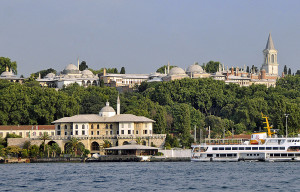In 1453, Muslim forces under 21-year old Sultan Mehmed II conquered Constantinople, the last bastion of the Byzantine Empire. Mehmed renamed the city Istanbul and proclaimed it the capital of his Ottoman Empire. For his new palace he selected a 175-acre site on a hill overlooking the Bosporus that separates Europe from Asia. When completed, what became known as the Topkapı Palace comprised dozens of buildings scattered among four large courtyards, reportedly suggesting earlier Ottoman tent encampments. At its peak, the palace accommodated 4,000 people, including hundreds of concubines eager to catch the sultan’s eye and bear his son. An enormous kitchen, with 10 domes, 20 chimneys and a staff of 800, provided thousands of meals every day. A handsome library stored 3,500 important manuscripts, including an early copy of the Quran. The Tower of Justice, visible from the Bosporus, symbolized the reputed fairness of the sultan, whose justice included public beheadings in the first courtyard near the Byzantine church of Hagia Irene.
After the Ottoman Empire collapsed in1923, the palace was converted to a museum. The ticket booth is near an ornate fountain where the executioner reportedly washed his sword after exacting the sultan’s justice. The former treasury building displays the 86-carat Spoonmaker’s Diamond, the world’s fourth largest diamond. What were once private rooms of the sultans now display religious relics collected from around the empire. For Muslims, the cloak, sword, banner and beard hairs of Muhammad are the most revered. Visitors who check their skepticism at the gate can also view the cooking pot of Abraham, the staff of Moses, the coat of Joseph, the sword of David and the right hand of John the Baptist.
In 2013, the Topkapı Palace surpassed Hagia Sophia as the most popular destination in Istanbul, with the faithful often lined up to see the religious items. A visit to the harem, once supervised by the sultan’s mother, requires a separate ticket.

Comments are closed.